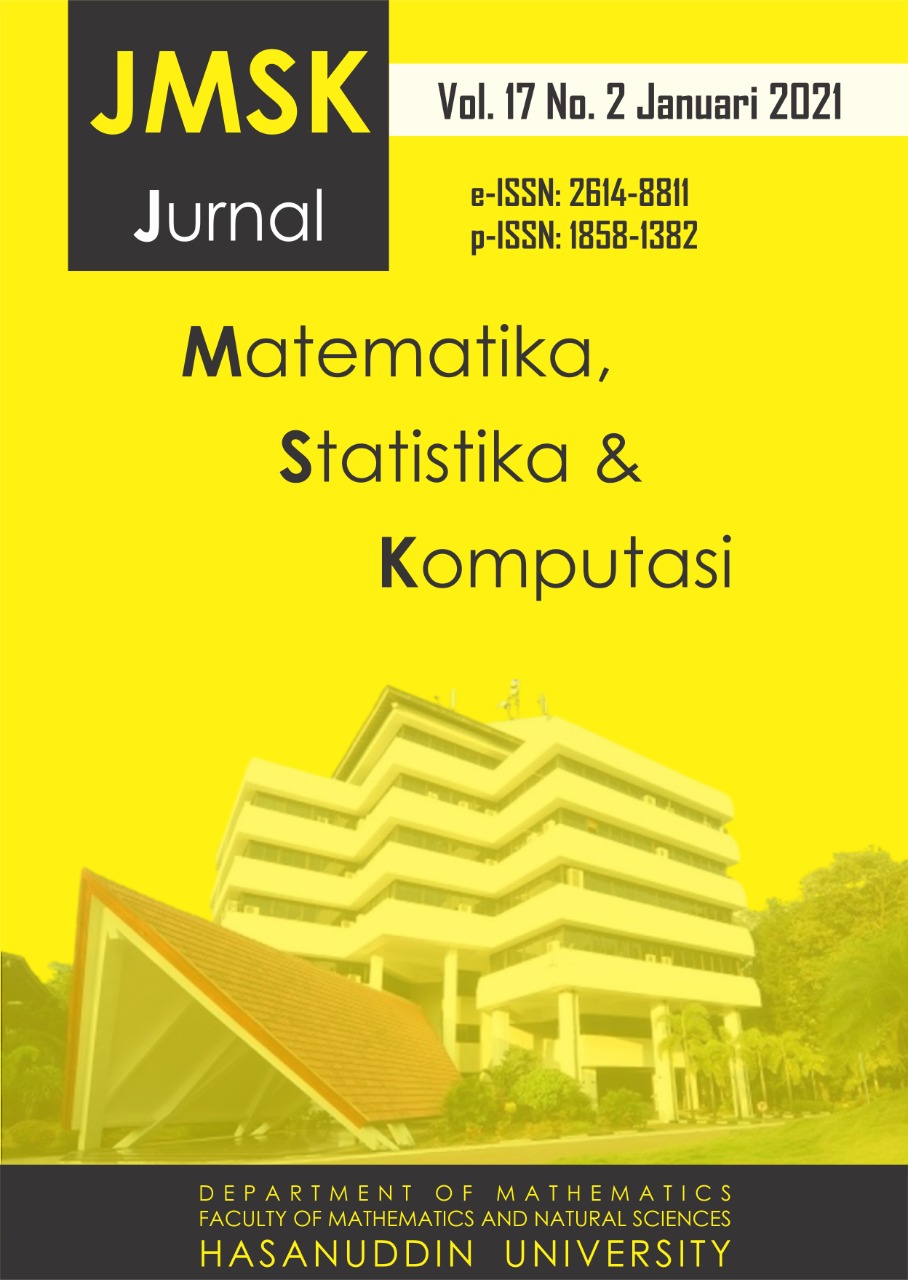Stability Analysis of a Mathematical Model in Inflammatory Response System Due to SARS Coronavirus Infection
DOI:
https://doi.org/10.20956/jmsk.v17i2.11995Keywords:
inflammation, SARS Coronavirus, basic reproduction numberAbstract
Severe Acute Respiratory Syndrome (SARS) Coronavirus infection in a human body indicated by cytokine response due to an inflammation. The purpose of this research is to construct and analyze a mathematical model of interaction between inflammatory pro-response and anti-response cytokine to predict the dynamic on inflammatory response system, so that the treatment can be optimized. The results obtained in this research describe some dynamics which happen on the cytokines, i.e. the disease-free equilibrium point is asymptotically stable when the basic reproduction number is less than one. In this condition, a patient with initial concentrations of the cytokines around the disease-free equilibrium point will be free of viral infection. The infection equilibrium point is asymptotically stable when the basic reproduction number is greater than one. In this condition, a patient with initial concentrations of the cytokines around the infection equilibrium point will be infected by the virus. Probability of a patient being free of viral infection can increase if the production rate of the cytokines are decreased or the degradation rate of the cytokines are increased.Downloads
References
Aprilyani, L. D. S., Kasbawati, & Toaha, S., 2020. Analisis Kestabilan Model Matematika Infeksi Penyakit HIV dengan Pengaruh Terapi Antiretroviral. Jurnal Matematika, Statistika, & Komputasi, Vol. 17, No. 1, 109-116.
Brady, R., Frank-Ito, D. O., Tran, H. T., Janum, S., Moller, K., Brix., S., Ottesen, J. T., Mehlsen, J. & Olufsen, M. S., 2018. Personalized Mathematical Model of Endotoxin-Induced Inflammatory Responses in Young Men and Associated Changes in Heart Rate Variability. Math. Model. Nat. Phenom., Vol. 13, No. 5, 1-20.
Driessche, P.V.D. & Watmough, J., 2002. Reproduction Numbers and Sub-threshold Endemic Equilibria for Compartmental Models of Disease Transmission. Mathematical Biosciences, Vol. 180, 29-48.
Frieman, M., Heise, M. & Baric, R., 2008. SARS Coronavirus and Innate Immunity. Virus Res., Vol. 133, No. 1, 101-112.
Hale, J. K. & Kocak, H. 1991. Dynamics and Bifurcations, Third Edition. Springer-Verlag, New York.
He, D., Zhang, C., He, X., Shen, W., Li, H. & Zhao, G., 2006. Expression of Elevated Levels of Pro-inflammatory Cytokines in SARS-CoV-Infected ACE2+ Cells in SARS Patients: Relation to the Acute Lung Injury and Pathogenesis of SARS. J. Pathol., Vol. 210, No. 3, 288-297.
Henderson, B., Seymour, R. & Wilson, M., 1998. The Cytokine Network in Infectious Disease. EOS, Vol. 18, 7-14.
Hu, B., Ge, X., Wang, L.-F. & Shi, Z., 2015. Bat Origin of Human Coronaviruses. Virol. J., Vol. 12, 221.
Jones, K. E., Patel, N. G., Levy, M. A., Storeygard, A., Balk, D., Gittleman, J. L. & Daszak, P., 2008. Global Trends in Emerging Infectious Diseases. Nature, Vol. 451, No. 7181, 990-993.
Li, W., Shi, Z., Yu, M., Ren, W., Smith, C., Epstein, J. H.., Wang, H., Crameri, G., Hu, Z. & Zhang, H., 2005. Bats are Natural Reservoirs of SARS-like Coronaviruses. Science, Vol. 310, No. 5748, 676-679.
Liu, Q., Zhou Y.-H. & Yang, Z.-Q., 2016. The Cytokine Storm of Severe Influenza and Development of Immunomodulatory Therapy. Cell. Mol. Immunol., Vol. 13, No. 1, 3-10.
Lloyd-Smith, J. O., George, D., Pepin, K. M., Pitzer, V. E., Pulliam, J. R., Dobson, A. P., Hudson, P. J. & Grenfell, B. T., 2009. Epidemic Dynamics at the Human-Animal Interface. Science, Vol. 326, No. 5958, 1362-1367.
McInnes, I. & Schett, G., 2007. Cytokines in the Pathogenesis of Rheumatoid Arthritis. Nat Rev. Immunol., Vol. 7, No. 6, 429-442.
Nursamsi, Toaha, S. & Kasbawati, 2020. Analisis Kestabilan Model Penyebaran Penyakit Tuberkulosis pada Penderita Diabetes Mellitus dengan Faktor Pengobatan. Jurnal Matematika, Statistika, & Komputasi, Vol. 17, No. 1, 50-60.
Peiris, J. S. M., Cheung, C. Y., Leung, C . Y. H. & Nicholls, J. M., 2009. Innate Immune Responses to Influenza A H5N1: Friend or Foe? Trends Immunol., Vol. 30, No. 12, 574-584.
Perko, L. 2001. Differential Equations and Dynamical System, Third Edition. Springer-Verlag, New York.
Prawandani, N., Toaha, S. & Kasbawati, 2020. Model Matematika VSEIR Penyebaran Penyakit Antraks pada Populasi Hewan dengan Efek Vaksinasi dan Pengobatan. Jurnal Matematika, Statistika, & Komputasi, Vol. 17, No. 1, 14-25.
Safronetz, D., Zivcec, M., Lacasse, R., Feldmann, F., Rosenke, R., Long, D., Haddock, E., Brining, D., Gardner, D. & Feldmann, H., 2011. Pathogenesis and Host Response in Syrian Hamsters following Intranasal Infection with Andes Virus. PloS Pathog., Vol. 7, No. 12, e1002426.
Seymour, R. & Henderson, B., 2001. Pro-Inflammatory-Anti-Inflammatory Cytokine Dynamics Mediated by Cytokine-Receptor Dynamics in Monocytes. Math. Med. Biol., Vol. 18, No. 2, 159-192.
Sulma, Toaha, S. & Kasbawati, 2020. Analisis Kestabilan Model Matematika Dinamika Penyebaran Penyakit Meningitis dengan pengaruh Vaksinasi, Kampanye, dan Pengobatan. Jurnal Matematika, Statistika, & Komputasi, Vol. 17, No. 1, 71-81.
Szretter, K., Gangappa, S., Lu, X., Smith, C., Shieh, W.-J., Zaki, S., Sambhara, S., Tumpey, T. & Katz, J., 2007. Role of Host Cytokine Responses in the Pathogenesis of Avian H5N1 Influenza Viruses in Mice. J. Virol., Vol. 81, No. 6, 2736-2744.
Zhang, W., Jang, S., Jonsson, C. B. & Allen, L. J. S., 2018. Models of Cytokine Dynamics in the Inflammatory Response of Viral Zoonotic Infectious Diseases. Mathematical Medicine and Biology: A Journal of the IMA, Vol. 36, No. 3, 269-295.
Downloads
Published
How to Cite
Issue
Section
License
Copyright (c) 2020 Author and publisher

This work is licensed under a Creative Commons Attribution 4.0 International License.

This work is licensed under a Creative Commons Attribution 4.0 International License.
Jurnal Matematika, Statistika dan Komputasi is an Open Access journal, all articles are distributed under the terms of the Creative Commons Attribution License, allowing third parties to copy and redistribute the material in any medium or format, transform, and build upon the material, provided the original work is properly cited and states its license. This license allows authors and readers to use all articles, data sets, graphics and appendices in data mining applications, search engines, web sites, blogs and other platforms by providing appropriate reference.








